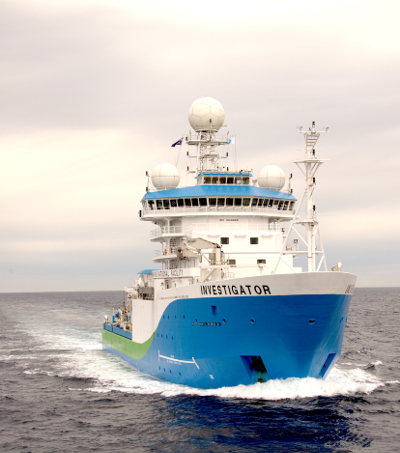Investigator brings data bounty
 Australia’s ocean detectives have returned from an epic voyage with new climate clues.
Australia’s ocean detectives have returned from an epic voyage with new climate clues.
The longest science voyage by CSIRO research vessel RV Investigator has returned to Australia with one of the most comprehensive datasets ever collected in the Southern Ocean.
Over 60 days and 12,000 kilometres, the voyage led by the Australian Antarctic Program Partnership (AAPP) and Australia’s national science agency CSIRO travelled south from Hobart, west along the Antarctic ice edge, then north to arrive in Fremantle tomorrow.
Co-chief scientist Dr Steve Rintoul (from CSIRO and AAPP) said the new data, collected from the ocean abyss up to six kilometres deep to low-lying clouds two kilometres high, will provide important clues about how the Southern Ocean drives climate patterns in Australia and the rest of the globe.
“The work reveals how microbes in the ocean control the brightness of clouds in the sky, how melting of the Antarctic Ice Sheet is altering deep ocean currents that extend around the planet, and how much iron is available to support growth of marine plants.”
“This critical research into physics, biology and chemistry provides new insights to how the ocean, atmosphere, ice and marine life are interconnected and how these interactions regulate climate,” Dr Rintoul said.
Co-chief scientist on RV Investigator, Dr Annie Foppert from AAPP at the University of Tasmania, applauded the hard work and dedication of the 39 scientists and 20 crew.
“The success of this voyage depended on a lot of different people, from the scientists to the ship’s crew and support teams on board and at home, working together as one team to collect crucial data that will benefit everyone in Australia.”
“Our long lap around the Southern Ocean was the equivalent of driving between Sydney and Perth three times – at a maximum speed of 20 kilometres an hour.”
“At our pre-planned sampling stations, we collected 100 vertical profiles of ocean properties by lowering and raising equipment which travelled about 700,000 metres through the water – at one metre a second.”
“We deployed 22 robotic floats, 12 sampling the full depth of the ocean and 10 with extra sensors to sample the biogeochemistry of the upper 2000 metres, that continue to track how the deep ocean is changing.”
“For me, it’s super exciting to see data in real time as we collect it – like the ocean continuing to store carbon dioxide from the atmosphere, or the concentrations of cloud-seeding particles changing as winds shift direction – and bring it all home to piece the whole story together,” Dr Foppert said.
Scientific achievements of the MISO voyage (Multidisciplinary Investigations of the Southern Ocean) include:
-
First comprehensive measurements of iron, and other trace elements essential for marine life, in this part of the ocean;
-
New observations that extend longest record of deep ocean change south of Australia;
-
New observations that allow the tracking of how much carbon dioxide the Southern Ocean is removing from the atmosphere and storing in the deep ocean;
-
An array of novel deep floats deployed, delivering snapshots of ocean conditions every ten days, from the sea surface to the sea floor;
-
First experiments analysing both the air and water within special onboard incubation tanks to measure how the composition and health of marine biota affect the emission of cloud-seeding gases.
Dr Rintoul said that to meet the challenges of a changing climate, we need to know what lies ahead.
“We know that the ocean has taken up more than 90 per cent of the extra heat stored by the planet in response to increased greenhouse gases in the atmosphere – global warming is ocean warming – and that the Southern Ocean stores more heat than any other part of the ocean.”
“The Southern Ocean also takes up and stores more carbon dioxide than other parts of the ocean. By soaking up large amounts of heat and carbon, the Southern Ocean slows the pace of climate change.”
“Better understanding of the Southern Ocean and its role in the earth system is essential to anticipate future climate change and its impacts.”
“By providing the foundation for more skilful weather and climate projections for Australia and the rest of the globe, the MISO voyage will help decision-makers in government, industry and the community make tough decisions based on the best possible science,” Dr Rintoul said.








 Print
Print